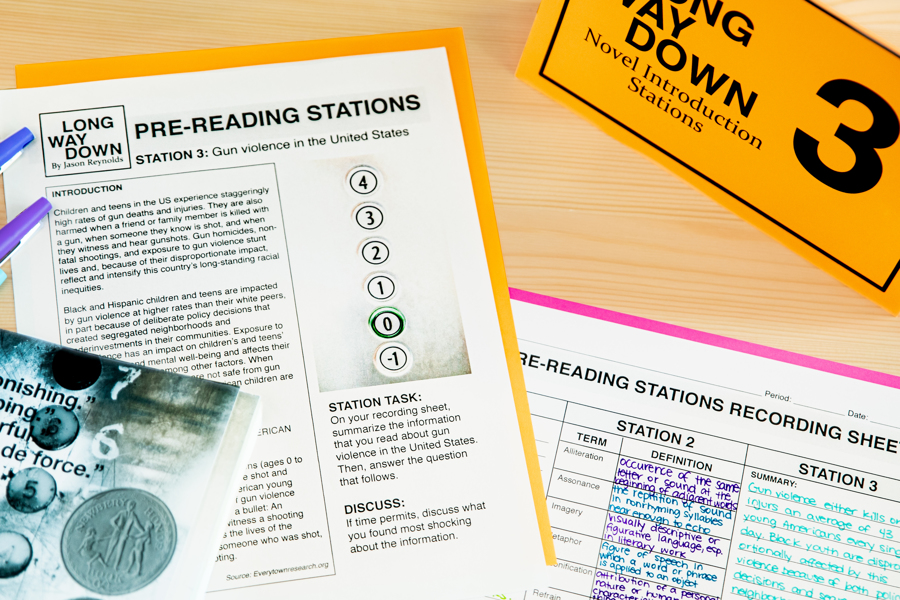Presentation and strategy are everything when you’re introducing a novel to your class, especially if you have a few (or more) resistant readers in the mix. That is why it is important to introduce a novel in an exciting and engaging way!
If you think about how important first impressions are when you’re meeting someone new, it should come as no surprise that the same principle applies to your students’ first encounter with a new book.
If you’re planning on reading a core text with your students, chances are they’ve come into your classroom with a fixed mindset about said book. They may have already decided whether or not it’s going to be worth their time. As teachers, we all know that rich learning experiences stem from our students’ initial buy-in.
Language arts teachers all desire that magical formula for getting our kids to love our books as much as we do, but how do we achieve it? To give you some inspiration, I’ve put together several of my favorite engaging ways to introduce a class novel that will get them excited from Day One.
Here are 4 Engaging Ways to Introduce a Novel
1. Introducing a Novel: Anticipation Guides
Anticipation guides are a low-prep way to jumpstart students’ thinking about the main topic, conflicts, and ideas surrounding your next class novel. I used to give these to my kids the old-fashioned way on pen and paper, but now I typically send my anticipation guides as Google Forms.
Each student has a chance to look over the questions, there’s never a chance I’ll lose their answers, and I can easily throw up the aggregated results on my SmartBoard.
2. Introducing a Novel: Pre-Reading Introduction Stations
 One of my all-time favorite ways to introduce class novels to students is with introduction stations. There are so many benefits to this type of active learning activity, notably the fact that students are up, moving around, and engaging with their peers in focused discussions.
One of my all-time favorite ways to introduce class novels to students is with introduction stations. There are so many benefits to this type of active learning activity, notably the fact that students are up, moving around, and engaging with their peers in focused discussions.
Your introduction stations don’t need to be overly complex, and you don’t need to overdo it on the prep side.
I recommend selecting no more than five topics for your first go-around. They can be anything from intriguing quotes from the novel, a short author biography, relevant and captivating photos or artwork, newspaper articles, etc.
Just remember to post a question or prompt at each station for students to answer and discuss with one another.
3. Introducing a Novel: Student-Paced Digital Novel Introductions 
Student-paced digital novel introductions are an excellent option if you like the high-interest engagement factor of introduction stations but have one or two classes where peer-to-peer interaction is like pulling teeth.
These digital introductions to class novels are usually Google Slides with various anticipatory texts, activities, and prompts to start generating discussion. I’ve even had my students use the Comment feature to trade ideas in real-time.
You can design your own novel introduction slide decks or check out fully-prepped options like the one I’ve created for Animal Farm.
4. Introducing a Novel: Meet the Main Character Press Conference
Suppose you have a flair for the dramatic and enjoy incorporating acting and role-playing into your pedagogy. Why not hold a character press conference for the main character of your class novel? After all, your students more than likely already have internal biases against them, so this is a fun way to “set the record straight.”
I suggest coming up with several questions beforehand that you can pass out to students but then opening up the floor for discussion afterward. Dressing as the main character and possibly using an accent are all pluses in my book. Your students might give you a hard time, but I guarantee they’ll remember that particular lesson much longer than others!
I often find that I am so much more excited about some of my class novels than my students are (at least initially). However, that quickly changes with the right attitude and a few engaging ways to introduce your students to their next great read.
After you introduce the novel in a fun and engaging way, consider these fun end of novel activities!


